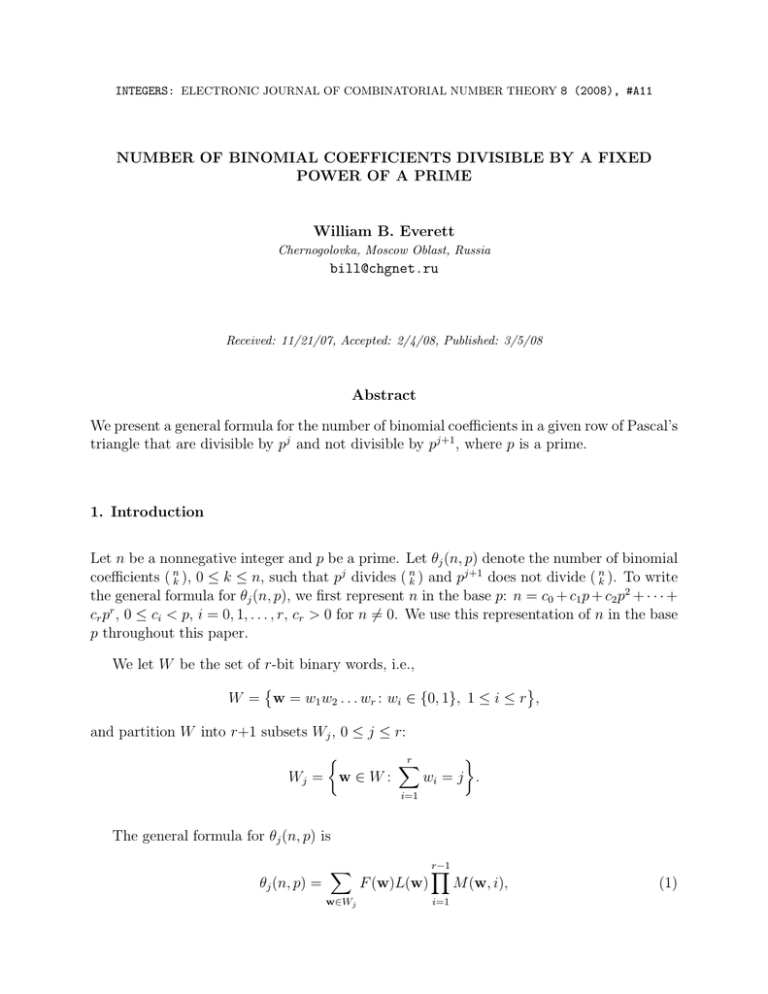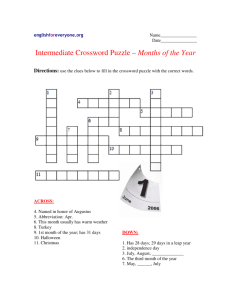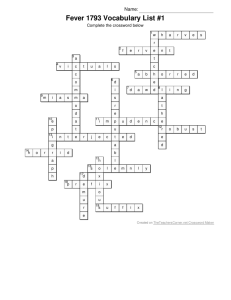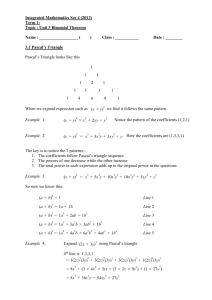NUMBER OF BINOMIAL COEFFICIENTS DIVISIBLE BY A FIXED William B. Everett
advertisement

INTEGERS: ELECTRONIC JOURNAL OF COMBINATORIAL NUMBER THEORY 8 (2008), #A11
NUMBER OF BINOMIAL COEFFICIENTS DIVISIBLE BY A FIXED
POWER OF A PRIME
William B. Everett
Chernogolovka, Moscow Oblast, Russia
bill@chgnet.ru
Received: 11/21/07, Accepted: 2/4/08, Published: 3/5/08
Abstract
We present a general formula for the number of binomial coefficients in a given row of Pascal’s
triangle that are divisible by pj and not divisible by pj+1 , where p is a prime.
1. Introduction
Let n be a nonnegative integer and p be a prime. Let θj (n, p) denote the number of binomial
coefficients ( nk ), 0 ≤ k ≤ n, such that pj divides ( nk ) and pj+1 does not divide ( nk ). To write
the general formula for θj (n, p), we first represent n in the base p: n = c0 + c1 p + c2 p2 + · · · +
cr pr , 0 ≤ ci < p, i = 0, 1, . . . , r, cr > 0 for n "= 0. We use this representation of n in the base
p throughout this paper.
We let W be the set of r-bit binary words, i.e.,
!
"
W = w = w1 w2 . . . wr : wi ∈ {0, 1}, 1 ≤ i ≤ r ,
and partition W into r+1 subsets Wj , 0 ≤ j ≤ r:
#
%
r
$
Wj = w ∈ W :
wi = j .
i=1
The general formula for θj (n, p) is
θj (n, p) =
$
w∈Wj
F (w)L(w)
r−1
&
i=1
M (w, i),
(1)
INTEGERS: ELECTRONIC JOURNAL OF COMBINATORIAL NUMBER THEORY 8 (2008), #A11
where the functions F (w), L(w), and M (w, i) are defined as
'
c0 + 1
if w1 = 0,
F (w) =
p − c0 − 1 if w1 = 1,
'
cr + 1 if wr = 0,
L(w) =
cr
if wr = 1,
ci + 1
if wi = 0 and wi+1
p − c − 1 if w = 0 and w
i
i
i+1
M (w, i) =
ci
if wi = 1 and wi+1
p − ci
if wi = 1 and wi+1
2
= 0,
= 1,
= 0,
= 1.
Formula (1) reproduces known formulas for some particular values. For example, for
j = 0, we obtain the known formula [1]
θ0 (n, p) = (c0 + 1)(cr + 1)(c1 + 1) · · · (cr−1 + 1)
= (c0 + 1)(c1 + 1) · · · (cr + 1).
For j = 1, we obtain the known formula [2]
θ1 (n, p) = (c0 + 1)cr (c1 + 1)(c2 + 1) · · · (cr−2 + 1)(p − cr−1 − 1)
+ (c0 + 1)(cr + 1)(c1 + 1)(c2 + 1) · · · (p − cr−2 − 1)cr−1
+ ···
+ (c0 + 1)(cr + 1)(p − c1 − 1)c2 (c3 + 1) · · · (cr−1 + 1)
+ (p − c0 − 1)(cr + 1)c1 (c2 + 1) · · · (cr−1 + 1)
r−1
$
=
(c0 + 1) · · · (ck−1 + 1)(p − ck − 1)ck+1 (ck+2 + 1) · · · (cr + 1).
k=0
Other particular formulas for θj (n, p) can be found in [3] and [4].
We find a matrix representation convenient for considering questions of the prime divisibility of Pascal’s triangle. We describe this matrix representation in Sec. 2. Based on
this representation, we construct what we call a “crossword” for a row in Pascal’s triangle in
Sec. 3. Each vertical “word” in the crossword corresponds to a binomial coefficient in the row
of Pascal’s triangle. The “letters”(zero or one) in the vertical word correspond to the carries
in Kummer’s theorem on the highest power of a prime that divides a binomial coefficient [5].
In Sec. 4, we use the relations between the structures of the horizontal “words” to construct
formula (1).
INTEGERS: ELECTRONIC JOURNAL OF COMBINATORIAL NUMBER THEORY 8 (2008), #A11
3
2. Matrices
For considering the prime divisibility of the binomial coefficients in Pascal’s triangle, we use
a sequence of square matrices of sizes p, p2 , p3 , . . . containing zeros on the main diagonal and
in the lower triangle and ones in the upper triangle above the main diagonal. Letting M
be the p×p matrix containing all ones and I be the p×p identity matrix, we can define the
sequence of prime divisibility matrices Ti for Pascal’s triangle recursively:
'
0, i ≥ j,
T1 = (tij ),
tij =
i, j = 1, 2, . . . , p,
1, i < j,
(2)
Tn+1 = Tn ⊗ M + I ⊗ Tn ,
n > 0,
where A⊗B is the Kronecker product of the matrices A and B (also called the tensor product
or outer product). As a simple illustrative example, we write the first three T matrices for
p = 2 (in a condensed format to save space):
01
,
00
0111
0011
,
0001
0000
01111111
00111111
00011111
00001111
.
00000111
00000011
00000001
00000000
Using these matrices, we can recursively define a sequence of matrices Hi containing the
degrees of the highest power of the prime p that divides each binomial coefficient in Pascal’s
triangle:
H1 = T1 ,
(3)
Hn+1 = Tn+1 + M ⊗ Hn , n > 0.
We illustrate this with the specific example of H1 and H2 for p = 3:
011
H1 = 001 ,
000
011111111
001111111
000111111
000011111
111
011
H2 = 000001111 + 111 ⊗ 001
000000111
111
000
000000011
000000001
000000000
INTEGERS: ELECTRONIC JOURNAL OF COMBINATORIAL NUMBER THEORY 8 (2008), #A11
4
011111111
011011011
001111111
001001001
000111111
000000000
000011111
011011011
= 000001111 + 001001001
000000111
000000000
000000011
011011011
000000001
001001001
000000000
000000000
022122122
002112112
000111111
011022122
= 001002112 .
000000111
011011022
001001002
000000000
The main diagonal and lower triangle of Hi correspond to the rows 0 through pi − 1 of
Pascal’s triangle, and the upper triangle is ready to appear in rows pi through pi+1 − 1 at
the next iteration of the recursion.
In passing, we note that the sequence of matrices Ri , i = 1, 2, . . . , corresponding to
Pascal’s triangle modulo p can also be defined recursively:
j > i,
0,
R1 = (rij ),
rij = 1,
i, j = 1, 2, . . . , p,
j = 1,
(4)
ri−1,j−1 + ri−1,j mod p, 1 < j ≤ i,
Rn+1 = R1 ⊗ Rn ,
n > 0,
where the matrix elements are multiplied modulo p. Then ( nk ) modulo p is the element
rn+1,k+1 of the matrix Rm , pm > n.
3. Crossword
In constructing formula (1), we use a crossword Cn,p consisting of an r×(n+1) array of zeros
and ones, where r is the degree of the highest power of p not exceeding n. The sum of the
zeros and ones in a vertical word is equal to the degree of the highest power of p dividing
the binomial coefficient in the corresponding position in the nth row of Pascal’s triangle. We
INTEGERS: ELECTRONIC JOURNAL OF COMBINATORIAL NUMBER THEORY 8 (2008), #A11
5
build the crossword using “powers” of the basic T matrices recursively defined as
Ti1 = Ti ,
Tim = M ⊗ Tim−1 ,
m > 1.
The ith horizontal word in Cn,p is defined as the first n+1 elements of the (n+1)th row of
Tim , where m is sufficiently large (so that Tim in fact contains an (n+1)th row).
As a simple illustrative example, we give the crosswords Cn,3 for n = 27, 28, 29, 30:
n = 27 :
0110110110110110110110110110
0111111110111111110111111110 ,
0111111111111111111111111110
n = 28 :
00100100100100100100100100100
00111111100111111100111111100 ,
00111111111111111111111111100
n = 29 :
000000000000000000000000000000
000111111000111111000111111000 ,
000111111111111111111111111000
n = 30 :
0110110110110110110110110110110
0000111110000111110000111110000 .
0000111111111111111111111110000
Kummer’s theorem [5] states that the degree of the highest power of a prime p that
divides the binomial coefficient
, n
n!
=
k
k!(n − k)!
is equal to the number of carries when adding k and n − k in the base p. We illustrate this
with the example of n = 27 and p = 3:
carry
000 111 111 110 111 111 110 111 111
k
0
1
2
10
11
12
20
21
22
n−k
1000 222 221 220 212 211 210 202 201
n = k + (n−k) 1000 1000 1000 1000 1000 1000 1000 1000 1000
100 111 111 110 111 111 110 111 111
100 101 102 110 111 112 120 121 122
200 122 121 120 112 111 110 102 101
1000 1000 1000 1000 1000 1000 1000 1000 1000
100 111 111 110 111 111 110 111 111 000
200 201 202 210 211 212 220 221 222 1000
100
22
21
20
12
11
10
2
1
0
1000 1000 1000 1000 1000 1000 1000 1000 1000 1000
Comparing the carries here with the crossword C27,3 above makes the correspondence clear:
the top row in the crossword corresponds to the least significant carry position (31 in this
INTEGERS: ELECTRONIC JOURNAL OF COMBINATORIAL NUMBER THEORY 8 (2008), #A11
6
example), and the bottom row corresponds to the most significant carry position (33 in this
example).
4. Constructing the Formula
The column sums of the r×(n+1) crossword Cn,p are the degrees of the highest powers of
p dividing the corresponding binomial coefficients. In other words, the sum of the (k+1)th
column in the crossword is the number of carries when adding k and n − k in the base p. To
construct formula (1), we must determine how many columns in the crossword produce the
given value j as their column sum. The subset Wj defined in Sec. 1 contains all the possible
vertical words containing exactly j ones. If we can determine the number of occurrences of
a given vertical word in the crossword, then we can sum these numbers over the words in
Wj to obtain the total number of binomial coefficients ( nk ), 0 ≤ k ≤ n, that are divisible by
pj and not divisible by pj+1 .
To determine the number of occurrences of a given vertical word in the crossword Cn,p ,
we study the structure of the horizontal words and, in particular, the relation between the
ith and the (i+1)th horizontal words. To facilitate the discussion, we introduce auxiliary
variables mi and si (depending on n and p) and a notation for substrings in the horizontal
words. Recalling the representation of n in the base p, n = c0 + c1 p + c2 p2 + · · · + cr pr ,
0 ≤ ci < p, i = 0, 1, . . . , r, cr > 0 for n "= 0, we define the auxiliary variables as
mi = ci + ci+1 p + ci+2 p2 + · · · + cr pr−i ,
si = c0 + c1 p + c2 p2 + · · · + ci−1 pi−1
(5)
(6)
for 1 ≤ i ≤ r. Clearly, n = mi pi + si , 0 ≤ si < pi .
Before defining the substring notation, we mention some obvious properties of the matrices Tim underlying the structure of the horizontal words. Clearly, each horizontal word ends
on the main diagonal of the matrix Tim from which it was taken (n + 1 = n + 1). It follows
from the structure of the matrices Tim (a transition from zero to one in Ti only occurs in
passing from the main diagonal into the upper triangle) that a transition from zero to one
in the ith horizontal word (i > 1) always coincides with a transition from zero to one in the
(i−1)th horizontal word except when the (i−1)th horizontal word contains only zeros.
We let Ii denote a substring in the ith horizontal word consisting of ones and preceded
by a zero and followed by a zero. Letting "( · ) denote the length of a substring, we have
"(Ii ) = pi − si − 1. We consider that a substring Ii of length 0 actually exists at a given
position in the word; this “convention” obviates the exception at the end of the preceding
paragraph and allows the subsequent argument to apply to all cases without exception. We
let Oi denote a substring in the ith horizontal word consisting of zeros and preceded and
followed by Ii (possibly with "(Ii ) = 0) or a word boundary. We have "(Oi ) = si + 1. We can
INTEGERS: ELECTRONIC JOURNAL OF COMBINATORIAL NUMBER THEORY 8 (2008), #A11
7
now represent the ith horizontal word in the crossword Cn,p as
[Oi Ii ]mi Oi ,
(7)
where [ · ]m denotes concatenation of m copies of the argument string. Clearly, "(Oi Ii ) = pi
and "([Oi Ii ]mi Oi ) = mi pi + si + 1 = n + 1.
Defining a projection π of a substring of the (i+1)th horizontal word (i > 1) to be the
substring of the ith horizontal word beginning and ending at the same locations, we have
π(Oi+1 ) = [Oi Ii ]ci Oi
(8)
π(Ii+1 ) = [Ii Oi ]p−ci −1 Ii .
(9)
and
We are now ready to determine the number of occurrences of a given vertical word in
the crossword Cn,p . We proceed from the top of the crossword (row 1) to the bottom of the
crossword (row r). If the first letter in the given vertical word is zero, then we want the
length of O1 , but if the first letter is one, then we want the length of I1 . We define our first
function F (w) as
'
"(O1 ) if w1 = 0,
F (w) =
"(I1 ) if w1 = 1.
By definition, "(O1 ) = s1 + 1 and "(I1 ) = p − s1 − 1. By (6), s1 = c0 . Consequently, we have
'
c0 + 1
if w1 = 0,
F (w) =
p − c0 − 1 if w1 = 1.
We now consider four cases for a two-bit substring in the word: 00, 01, 10, and 11.
Further, we need to do this for each of r−1 two-bit substrings beginning with the first letter,
the second letter, and so on to the next-to-last letter of the word. For the substring 00
starting from the ith letter, i = 1, 2, . . . , r − 1, we want to know how many times Oi occurs
within Oi+1 . From inspection of Eq. (8), we see that this is ci +1 times, and we also see that
Ii is included in Oi+1 ci times (corresponding to the two-bit substring 10). Similarly, from
Eq. (9), we see that Oi is included in Ii+1 p−ci −1 times (corresponding to the substring 01)
and Ii is included in Ii+1 a total of p − ci − 1 + 1 = p − ci times. We thus construct the
middle function
ci + 1
if wi = 0 and wi+1 = 0,
p − c − 1 if w = 0 and w = 1,
i
i
i+1
M (w, i) =
ci
if wi = 1 and wi+1 = 0,
p − ci
if wi = 1 and wi+1 = 1,
and to account for the r−1 two-bit substrings, we take the product
r−1
&
i=1
M (w, i).
(10)
INTEGERS: ELECTRONIC JOURNAL OF COMBINATORIAL NUMBER THEORY 8 (2008), #A11
8
Multiplying F (w) times product (10), we obtain the number of multiple occurrences of
the given word either in Or if the last letter in the word is zero or in Ir if the last letter in
the word is one. Our last step before summing over the words in Wj is to determine the
number of repetitions of either Or or Ir depending on the value of wr in the given vertical
word. From (7), we see that Or occurs mr +1 times and Ir occurs mr times. By definition (5),
mr = cr . We therefore write the last function
'
cr + 1 if wr = 0,
L(w) =
cr
if wr = 1.
Summing the product for each word over the set of words satisfying the criterion that
the number of ones in the word is exactly j, we obtain the general formula
. r−1
/
$
&
θj (n, p) =
F (w)
M (w, i) L(w).
w∈Wj
i=1
By the commutativity of ordinary multiplication, this is the same as formula (1) in Section
1.
References
[1] Fine, N. J.: Binomial coefficients modulo a prime. Amer. Math. Monthly 54, 589–592 (1947)
[2] Carlitz, L.: The number of binomial coefficients divisible by a fixed power of a prime. Rend. Circ. Mat.
Palermo (2) 16, 299–320 (1967)
[3] Howard, F. T.: The number of binomial coefficients divisible by a fixed power of 2. Proc. Amer. Math.
Soc. 29, 236–242 (1971)
[4] Howard, F. T.: Formulas for the number of binomial coefficients divisible by a fixed power of a prime.
Proc. Amer. Math. Soc. 37, 358–362 (1973)
[5] Kummer, E. E.: Über die Ergänzungssätze zu den allgemeinen Reciprocitätsgesetzen. J. Reine Angew.
Math., 44, 93–146, (1852)




